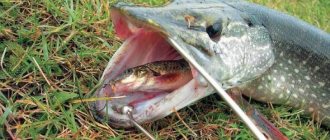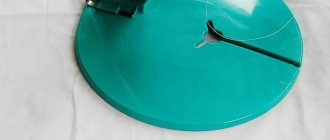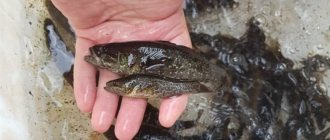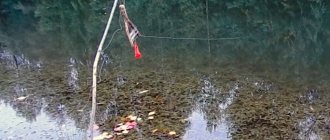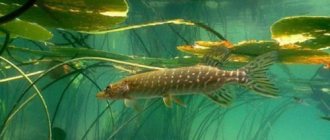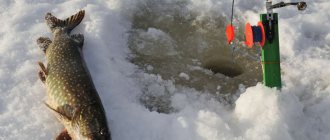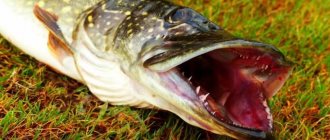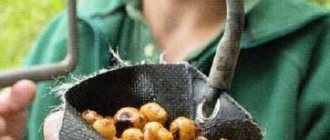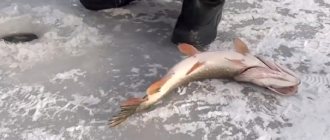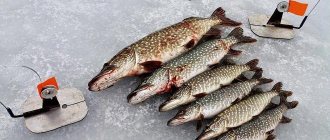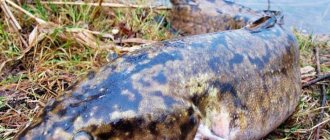Summer zherlitsa-postavusha
Traditionally, from time immemorial, pike have been caught using a summer bait-postavusha. It was a flyer like the one we used to make slingshots at school. A line is wound around the flyer in a figure eight, and a cut is made at one of its ends with a knife. A fishing line is inserted into it in such a way that the bait fish cannot pull it out, but the pike can. A piece of string is tied to the “handle” of the flyer. It is used to attach it to the base of the girder - a peg, pole, reed, hanging bushes or other objects near water, of natural or artificial origin. The main thing is that it is not tied tightly, but hangs on a free section of this string above the water.
At the moment of the bite, the pike grabs the bait and begins to pull the line. Under force, it jumps out of the tuck and rolls off the flyer. Winding in a figure eight prevents the line from getting tangled, which often happens when inertia-free reels such as bottles and tubes are used instead. The fishing line can simply fall off at once and a beard will form. Subsequently, the pike stops and swallows the bait, getting hooked. The signal to the angler is the sound of the line unwinding, but more often the fish hooks itself, and all that is required is to check the girders from time to time, remove the pikes and change live bait.
You can find a lot of variants of this girder. Fishermen make them from pieces of pipe, plastic cups and small plastic bottles instead of slingshots. Of course, for a city dweller it is easier to find them than to look for a smooth slingshot on the shore and come to the reservoir in advance with prepared gear, rather than waste time fishing to equip the girders. In addition, most of these devices can be fixed motionless, just to ensure the line comes off. They often do this: they put a wooden stake in the water with a piece of Ø50 mm PVC pipe for plumbing screwed to it, a small plastic bottle through a cork, etc. At the moment of biting, the fish itself pulls the line out of the pinch and unwinds it from an improvised reel of the inertia-free type. They are caught using baits in the summer and until late autumn.
Sometimes there are options when the reel does not have a reel at all. Usually these are placed with a sinker, when the live bait is held at the bottom. The slack of the line here is initially set in the form of sag to the sinker. The predator grabs the bait, tears the load off the bottom and picks up the slack.
Victoria Leshchenko
I've been working hard in the fishing tackle department for the past six years. I can help you assemble almost any gear.
Ask a Question
Sometimes the slack is made up to the tuck and is free on the water, but in this case it can get caught on something. Still, a flyer or some kind of device is more reliable. And the live bait that lies on the bottom is usually scared, lies on the ground, does not move and is less likely to cause a bite than one that is thrown into the water or above the bottom and does not know where to hide from the predator.
The process of making summer vents
For catching pike, perch, pike perch and other predatory fish in the summer, a girder that will float on the surface of the water is perfect. This type of tackle is called a circle.
To make a summer girder (mug) you will need:
- slingshot;
- fishing line;
- sinker;
- triple hook (single hook is also possible);
- wooden stake to secure it to the shore.
Instructions:
- tie the fishing line to the slingshot and wrap it around;
- the sinker, leash and float are assembled;
- put live bait on the hook;
- Attach the tackle on the shore to the branches of bushes that are located next to the reservoir.
Classic version
With the onset of the summer season, many reservoirs are overgrown with vegetation, and in order to build a good trap for pike, you need to take into account the hard-to-reach places where this fish lives. For example, someone who is used to catching pike in winter can easily convert a winter fishing rod into a summer one.
The main thing is to find the necessary elements to make a fishing line on which you can wind the fishing line. Mainly used:
- plastic circle;
- plastic bottle;
- piece of wood
There are also girders that can be installed on the water, but they require constant supervision so that it does not get sucked into snags.
To arrange a summer barn you need:
- choose the place where it will be attached;
- find a wooden flyer and attach a fishing line to it (the fishing line should be 0.5 mm thick and about 7 meters long);
- a sliding weight with a swivel to connect a 30-centimeter leash (necessary for currents);
- retaining rings;
- hooks (if the fisherman wishes, double and triple hooks can be used).
- After installation, tie the girder to a tree or branch hanging over the pond.
We do not recommend equipping the girder with a piece of fishing line that is too long and installing it on the girder, because the pike can take the tackle into the snag.
Use a boat to install the vent in the right place, because from the shore you will have to enter the thickets and water.
Jerky from a bottle
One of the simplest ways to make a zherlitsa is to use a bottle.
- a nylon thread is attached to the bottle, which is secured with an elastic band;
- the sinker is placed on the thread and a leash and hook are put on;
- the bottle is painted in a bright color;
- bait is baited, and the bottle is tied with a thread to a tree branch hanging over the pond.
The fisherman will only have to carefully monitor the fish to see if it has caught the bait.
Those who prefer to fish from a boat can also make a girder, only in this case they will need a large bottle, for example, a three-liter bottle.
Instructions:
- fasten the fishing line under the neck of the bottle, and wind a loop across it, which is held under the ring;
- You should pour some water into the bottle;
- make a small hole in the lid and neck of the bottle where you can tie a fishing line;
- then take the cord and fishing line, thread the fishing line through the bottom of the bottle and make a knot;
- pass the fishing line through the lid;
- Attach a sinker and several hooks with live bait to the fishing line.
When the pike grabs the bait, the lower part of the rod will rise, and the upper part will go deeper. Then you can fish the pike ashore.
Winter zherlitsa
For pike fishing, this type of gear works exactly the same as summer gear. The live bait is on a hook or tackle, which is designed to hook fish, the fishing line is in a tuck, from which he is not able to pull it out, but the pike - yes. On the girder there is a free supply of fishing line of about one and a half to two meters, usually on a reel, so that the pike, having taken the bait, has the opportunity to move away and swallow it without resistance.
Also, a special signaling flag is often placed on the winter shelter. It is usually mounted on a clock spring about half a meter long. Often it also acts as a tuck, pressing the reel and preventing the baitfish from reeling in the line. When you bite, the spring is released, the flag pops up and can be seen far away on the white ice. The fisherman runs up, hooks the fish and pulls it out onto the ice through the hole.
The design of winter vents is subject to the requirement of frost resistance. For example, it is performed on a wide plate stand. With its help, the girder is placed above the hole, covering it, and covered with snow on top. As a result, the fishing line underneath does not freeze into the ice, and the line can remain in one place for a long time, even in severe frost. The flag, reel and other parts must be made simply and reliably, maybe even crudely, so that even if a little ice has frozen on them, there will be gaps for their normal operation. The fishing line is also not the thinnest, so that it can be released with a jerk if it is a little frozen. And a thick line usually freezes into the edge more slowly than a thin line, which immediately sticks to the cold icy edge in severe frost.
The described option is usually purchased in a store. Such a girder on a plate stand is inexpensive and allows you to catch fish quite effectively. But there are other options for winter girders that allow you to catch fish with live bait. They can be made independently. For example, a simple vent made from a piece of plastic pipe with a cross, an underwater vent.
Making winter vents
In winter, they use homemade girders with a square or round stand, a bracket with a reel, and poles.
Winter perch with stand
The process of making a winter rate:
- Square blanks of stands measuring 250×250 mm are cut out of 8 m thick plywood using a jigsaw or a framer.
- A hole with a diameter of 8 mm is drilled in the center of the cut workpiece.
- A through cut 5-8 mm thick is made from the hole.
- A second hole with a diameter of 20 mm is drilled 50 mm from the central hole.
- The finished stand is coated with black waterproof paint.
- A piece 200-250 mm long is cut from a piece of polypropylene pipe for cold water.
- A conventional bobbin-type float reel with a ratchet brake and a flat spring alarm with a bright red flag at the end are attached to the top using electrical tape and heat-shrink tubing.
- 10-15 meters of monofilament fishing line with a thickness of 0.3-0.35 mm are wound onto a reel.
- A sliding sinker weighing 6-8 g is put on the main fishing line, and a metal leash with a tee or double is tied.
You can see how to properly make such a girder for pike in winter in the following video:
Six bet
Such a bet is a wooden pole of round or square cross-section, in the middle of which a coil is attached, and at the top there is a flat spring signaling device with a flag.
Lightweight and compact compared to the previous one, this design has one significant drawback: installed in a snowdrift or slush, such a bet is very inconvenient on the first, smooth, snow-free ice.
Astrakhan bottle
Volga fishermen figured out how to make a simple but quite convenient bet from an ordinary half-liter container of mineral water, beer or carbonated drink.
Such a simple girder called the “Astrakhan bottle” is made very simply: a piece of monofilament fishing line 4 to 10 meters long with the usual equipment at the end is tied to the neck of the bottle. The baited tackle is thrown into the hole, slightly raised above the bottom, after which the bottle is taken a little away and placed in the snow. When biting, the pike easily pulls the bottle out of the snow - if the angler manages to see the moment of the bite, he runs up to the triggered tackle and, grabbing the main line, makes a hook. If the moment of operation was not noticed, then the bottle falls into the hole and takes a vertical position in it like a large float or buoy. Pike, as a rule, are unable to pull away a plastic container filled with air.
A vent made from a piece of plastic pipe
For a girder made from a piece of plastic pipe, you actually need a piece of such a pipe 50-70 cm long. Holes are made in it through which a wire is passed near one of the ends of such a girder. Use two pieces of reinforcing wire, no thinner than 3-4 mm. The result is a pipe, at one end of which two pieces of wire are stuck crosswise. The other end rests freely on the ice. It turns out that the pipe lies in front of the hole, resting near it on the cross, and with the other end behind it on the ice.
A fishing line is wound onto the free end of the pipe following the cross. This end is an analogue of the roguli in the summer zherlitsa. The fishing line is secured in a pinch made with a knife on the edge of the pipe, or is not secured at all, since the live bait in its normal state is not able to pull it off. When the fish bites, it grabs the bait, pulls the fishing line, turns the bait upside down and drags it into the hole. A cross made of wire that stands across it prevents you from falling through the ice. There is a free supply of fishing line on the pipe, which allows the fish to move away and swallow the bait. The fisherman sees the girder turned upside down with a pipe from a distance, runs to it and hooks a fish. Often the pipe itself is painted in bright colors for better visibility so that it can be seen against the background of white snow.
The main disadvantage of such a girder is the complete unprotection of the fishing line from freezing. It will be impossible to fish like this in the cold; within 20-30 minutes the line will be crusted on the surface of the hole and the operation of the tackle will be disrupted. There are also difficulties in regulating the softness of operation. In winter, pike can have soft bites, when it carefully takes the fish and almost does not move from its place. In this case, the effort to turn the vent will not be enough.
Second manufacturing option
The second permanent version of a homemade girder is a method when it is made like a summer one, based on a flyer or other substitute device, and attached to a support on a string. In this case, the flyer is under water, and the end of the string is attached to a stick that lies across the hole. Even if the string freezes, it can be easily cut out of the ice without causing much damage. This will not work with a thin fishing line. The disadvantage of this rod is the complete absence of a bite alarm; it has no flag. The hooking of fish occurs by self-catching, because of this, with careful biting, there will be a lot of empty hooks from which the bait is eaten, and the fish leaves, or where it is dented, falls asleep, and the fish spits it out, feeling the hooks. But it can be made from a very small piece of pipe, from a hose, and such homemade products take up little space in your bag.
Another important quality of the girder is that it can be easily found on the ice. It happens that it is already dark outside and there is a snowstorm. It will be difficult for an angler with a flashlight to find a stick placed across the hole when both of them are covered with snow. At the same time, finding a folded flag protruding above the ice or a pole with a slingshot will be much easier.
There are other live bait winter gear that are not always designed for pike fishing. For example - access. They are made in the form of short pieces of fishing line with two or three hooks on leashes and are designed for catching fish from the bottom. Live bait or other predator bait is attached to the hooks. Predator: burbot, pike perch, perch. They are the ones who take bait directly from the bottom much more often; pike prefer live bait in mid-water. The classic approach is a pole stuck into the hole to the very bottom, to the lower edge of which a fishing line with hooks and nozzles is tied.
Victoria Leshchenko
I've been working hard in the fishing tackle department for the past six years. I can help you assemble almost any gear.
Ask a Question
Usually the burbot hooks itself, as it never moves far to the side to swallow the bait, like a pike, and swallows it on the spot, as do pike perch and pike perch.
It’s easy to find such a perch for burbot even after a snowfall - the stake will remain sticking out and can be clearly seen. There are no problems with ice crust. The hole can initially be filled with a thick layer of snow, and if it freezes completely, the crust can be stirred up with a stake or cut out of the ice without fear of cutting it with a pick. The baits are left overnight and checked in the morning; the bait for them is usually a ruff, which is caught all day. The one that doesn’t go for live bait goes for the fish.
All-season trap
A universal all-season self-trap for pike is made with your own hands as follows:
- A piece 100 mm long is cut from a polyethylene pipe with a diameter of 25 mm.
- The cut is processed with a file and sandpaper.
- Two through cuts with a depth of 7-8 mm are made in the walls of the ends of the tube, located crosswise relative to each other.
- At the end of the cuts (made with a hacksaw blade in the pipe wall of through grooves) of one cut, two holes are made with a 6 mm drill, and sharp corners and edges at the entrance of the cuts are cut off with a sharp knife.
- Then, 20-30 mm are retreated from the edge where the manipulations described above were performed and one hole is made with a drill with a diameter of 2 mm.
- On the opposite edge, crosswise to the cut made in the end of the pipe, two semicircular recesses are made using a round file.
- A strip of bright red self-adhesive film 50-55 mm wide is glued to the middle part of the tube.
- The end of the cord is passed into the single hole made, and a loop 150-200 mm long is made on it.
- The cord passed through the hole is secured with another double knot.
- A nylon cord is wound around the middle part of the pipe.
- A sliding sinker is placed on the end of the cord, a swivel with a carabiner is tied, to which a metal leash 150-200 mm long is fastened.
- A rubber band cut from a bicycle inner tube is threaded into the cut with holes.
In order to charge such a plane, they unwind the required amount of cord, place it on the live bait double, tighten the elastic band and fix it in the semicircular recesses at the opposite end of the tube. When biting, the elastic band slides out of the semicircular grooves and the pike that has swallowed the bait freely unwinds the entire cord from the tube.
Victoria Leshchenko
I've been working hard in the fishing tackle department for the past six years. I can help you assemble almost any gear.
Ask a Question
In winter, the loop at the end of the cord is placed on a long stick, after which the tackle is lowered into the hole. Due to this location, some fishermen call such a vent under the ice (underwater).
In the summer, samolov, like all other girders, are hooked to a long stake or branches of bushes or trees.
How to make a reliable and simple self-trap for pike is described in the video:
Equipment of the girder
Both summer and ice fishing poles require equipment. Be sure to put a leash on the pike, as it can bite through even thick fishing line. Tungsten and wire are used. It is also necessary to install the equipment with at least one swivel. It makes it much easier to get fish into the hole; the line will not twist when fishing and will be less tangled. Live bait is attached to one or two hooks. It must be placed by the lip, as the pike swallows it from the head. The second one, if there is one, is stuck at the base of the anal fin without damaging the internal organs. All sorts of methods, when a leash is threaded through the gills of a live bait, lead to the fact that it will fall off very quickly. Gills are a very important vital organ of fish.
It is also worth warning about the use of traps for pike and other traps that do not use hooks. All of them are illegal and poaching methods of obtaining fish. The number of bites on them is the same as on a hook, but there are many times more mutilated fish that did not fall into the hands of the fisherman. It is almost certain that a pike that leaves a trap dies. But she can get off an ordinary trap and get caught again a couple of hours later.
Manufacturing and modification of a sieve with a flag
The best option for a girder is on a wide base with a flag. He is proven and reliable. You can make it yourself, even if it doesn’t seem too complicated. All parts are made of plastic. There is no need to make anything out of wood; it gets wet from water and freezes, as a result the vent becomes heavy. The ice in the bag after fishing will begin to melt, and the fisherman’s things will be all in the water.
For the base, take a fairly thick plastic - a round or square piece. The base from a broken electric kettle and other parts of electrical appliances are suitable. All of them should not fall into the hole, that is, be larger than it. A spool stand and a flag are attached to the base. It is convenient to make a stand from a piece of thin 16 mm polypropylene plastic pipe.
It can be made removable, for this purpose a hole is made in the base, a self-tapping screw with a washer can be screwed into the rack from below, with which it will be pressed against the groove in the base, there may be other options. A slot is made in the base through which you can thread the fishing line so that it is lowered exactly in the middle of the hole. This will make it difficult for the pike to turn over the girder.
The reel is attached to the stand. This can be either a small wire reel or a reel from any fishing line on the bracket. It is important that it has a fairly easy move and sufficient clearances between the axles. It is advisable to lubricate this area very well with grease so that it does not allow water to get under the axle. The water will not freeze, the coil will not jam and everything will work well.
The flag is attached in such a way that it tightens the reel and prevents the baitfish from reeling in the fishing line. For the base of the flag, take a long twisted or flat clock spring. You can use an old broken construction tape, there is also a good plate there, however, it quickly rusts and can break during use. It is very important that the vent itself is dark in color. It will be clearly visible on light ice and snow and will be easy to find. Flags must be bright. Burgundy and cherry flags are best seen on white snow; orange and bright red ones are less visible, especially in a snowstorm.
Refinement of purchased models
Much more often, fishermen have to deal with modifications to purchased girders. These are used more often than homemade ones. They are not expensive and work better than most homemade ones. And if you assume that you will have to buy materials for homemade ones, the choice is completely obvious; purchased ones will be the best choice for an angler who just wants working gear, and not gear made by these very hands.
But they cannot always be used immediately. Often there is a defect left after casting plastic, a burr. All this needs to be cleaned with sandpaper or a file so that the fishing line does not catch on anything. The reel often has an unreliable fastening. Sometimes it is necessary to replace the axle and install a lock nut so that nothing unscrews on its own. Finding a lost nut in a thick snowdrift is almost impossible. Most often they try to glue the flags so that they do not fall off the spring. Usually they are simply stitched, sometimes poorly, and when bitten they can easily fly off when jerked. Glued with epoxy or frost-resistant glue.
It is advisable to lubricate the coil axis itself with a large amount of grease. It will not only improve the smoothness of the ride, but will also protect the gap between the axle from water getting in there. But you should be careful, solid oil corrodes some old fishing lines, such as nylon ones. It’s better to do everything in moderation and try not to have it on the entire surface of the reel, including the groove for the fishing line. Sometimes you need to attach a handle to the reel to rotate it. But you can do much better - drill a hole in the rim so that you can rotate it with your index finger. It is convenient to use this same hole to hook the hook from the girder onto it.
There are some other modifications to the purchased rig - correcting the crooked post above the gas, securing the flag spring in the insert base with glue, lengthening or shortening the flag, etc. The main thing is to apply a little force so that the rig works perfectly, and then fishing will be fun even at low costs.
